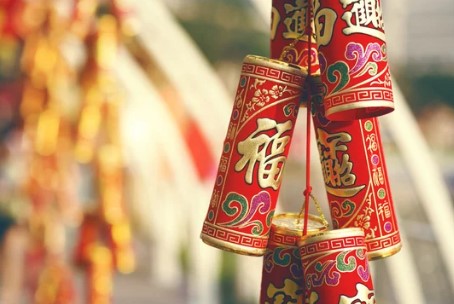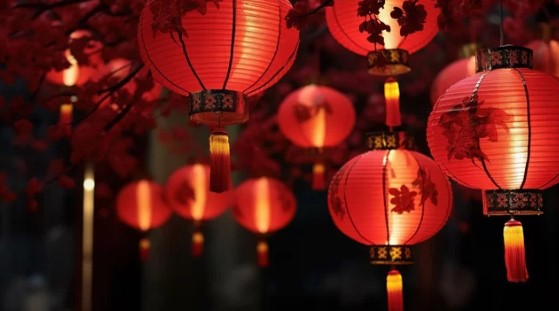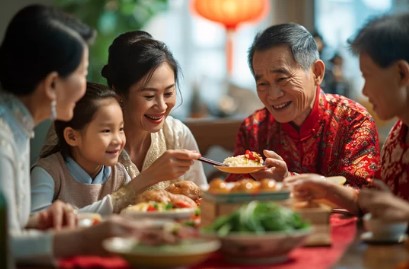Top 10 Chinese New Year traditions
6 February 2024

SHARE:
Chinese New Year is an incredibly vibrant and festive celebration filled with rich traditions. In the build up to Chinese New Year, also known as the Spring Festival (春节), we’ve put together some of the most fascinating and meaningful customs associated with the festival.
Here are 10 Chinese New Year traditions.
 |
1. Red envelopesOne of the oldest customs associated with Chinese New Year is exchanging red envelopes (or ‘hongbao’ 红包) filled with money during the festivities. Although primarily gifted to children, red envelopes are often given to friends and family, and sometimes even to employees as a token of appreciation. The significance lies not in the money within, but rather in the envelope itself, which represents luck and well wishes for the upcoming New Year. It's crucial to keep in mind, though, that the total amount in the envelopes should never contain the number 4, such as "40," "4", and so forth. This is to be avoided as the pronunciation of the number four in Chinese sounds like the word "death." |

|
2. FirecrackersTraditionally, firecrackers are set off during Chinese New Year as a way to commemorate the start of a new year and to fend off bad luck in favour of good fortune. The loud noises and bright lights are thought to ward off any negative energy and instead, creates a joyful atmosphere, ensuring a fresh start to the New Year. In essence, it signifies the conclusion of the Chinese New Year festivities. |
 |
3. Cleaning your homeBefore the festivities begin, many of those celebrating Chinese New Year give their homes a thorough cleaning since they don't want to bring the old stuff into the New Year. Think of it as starting with a clean slate and making room for good luck and positivity to enter the home. Additionally, a clean and tidy house is seen as a way to welcome the ancestors who visit during the New Year celebrations. Notably, cleaning is taboo on Chinese New Year as it’s believed that it might sweep luck and good energy away, so anything related to cleaning, sweeping, or taking out the rubbish must not be done until at least five days after New Year’s Eve! |
 |
4. Buying new clothes (avoid white and black!)In Chinese tradition, buying and donning new garments to greet the lunar New Year represents a fresh start, just like cleaning does. New beginnings are symbolised by new clothing, which is also believed to bring an abundance of luck for the upcoming year. Although it’s not necessarily about avoiding black and white colours during Chinese New Year, it’s important to consider not dressing in black and white while celebrating. Wearing these colours during Chinese New Year is said to be unlucky since they are connected to sadness and mourning. Rather, it’s preferable to wear vibrant colours like red and gold, which symbolise luck and fortune. To reduce the possibility of bad luck or offending someone, it is advised to stay away from these hues if you're celebrating the New Year! |
 |
5. DecorationsSignifying joy, luck, and prosperity for the New Year, the colour red is also predominately used in clothing, envelopes containing money, and decorations. Traditional decorations play a significant role in Chinese New Year celebrations, adding to the festive atmosphere and symbolizing good luck and prosperity. One of the most iconic decorations is the red lantern. These vibrant lanterns are hung both indoors and outdoors, illuminating the surroundings and bringing joy to the festivities. Another popular decoration is the couplet (or chunlian 春联). These are red scrolls adorned with auspicious phrases or blessings written in calligraphy, and are typically placed on doorways to invite positive energy into the home. You can also find paper cuttings with intricate designs displayed on windows to ward off evil spirits and bring blessings. Whether it's the red lanterns, couplets, or paper cuttings, these decorations play a vital role in preserving and celebrating Chinese New Year traditions. |
 |
6. Family reunionThis tradition in particular is incredibly important during Chinese New Year as it is a time for families to come together and celebrate. In Chinese culture, ‘family’ holds great significance and is considered to be the foundation of society. Every year, millions of people return to their hometowns to spend quality time with their loved ones. In China, this is known as Chun Yun (春运, meaning “moving in the spring”) which refers to the Spring Festival travel rush, the largest annual human migration in the world. Transportation systems, including trains, planes, and buses, become extremely crowded during this period as people travel long distances to reunite with their loved ones. |

|
7. FoodFood is an integral part of Chinese New Year, not just because it brings people together, but it holds deep symbolic meanings. Traditional dishes are carefully chosen for their auspicious qualities, such as longevity, abundance, and wealth. For example, dumplings symbolise wealth and good fortune, while fish represents surplus and prosperity. Nian gao (年糕), a sticky rice cake, signifies a higher position or better luck in the coming year. By sharing these special dishes with family and loved ones, it is believed that you are inviting good fortune and blessings into your life. Plus, it’s a delicious way to celebrate! |

|
8. Dragon and lion dancesWith both animals representing power, strength, and good luck, these lively and colourful dances are traditionally performed during the New Year. However, there are some differences between the two. The lion dance is usually performed by two people inside a lion costume, where they mimic the movements of a lion, including jumping, and rolling. On the other hand, the dragon dance involves a long dragon puppet that is held up by a team of performers where they must move in a coordinated manner to successfully mimic the creature's smooth, flowing movements. Both dances are accompanied by lively music, drums, and cymbals, which creates a festive and energetic atmosphere during the Chinese New Year celebrations. It’s a captivating sight and a wonderful way to bring joy and positive energy to the community! |

|
9. Flower market shoppingPeople usually purchase plants and flowers in hopes of having a good beginning to the New Year as it can represent rebirth and abundance. Giving fresh flowers, potted plants, and bouquets as gifts is a popular ritual on Chinese New Year's Day, especially in Hong Kong and Macau. This tradition carries a great deal of sentimental and emotional meaning, and the many types of flowers that are offered as gifts represent different wishes. For instance, give the recipient a moth orchid as a token of blessing and good fortune. |

|
10. Offerings for ancestorsAs part of Chinese New Year traditions and a payment of respect, gifts or ‘sacrifices’ are offered to deceased family members and ancestors. It’s believed that the spirits of ancestors return to visit their living descendants during this time. Offerings typically include food, fruits, and incense. This act of remembrance and gratitude strengthens the bond between the living and deceased, and it is seen as a way to receive blessings and protection from the ancestors for the coming year. |